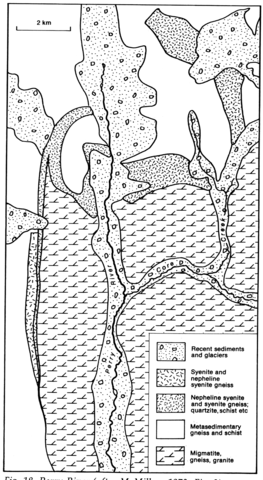stripes
Nepheline syenite gneisses are found as a conformable horizon 15- 300 m thick on the west flank of the Frenchman's Cap Dome. Beneath are quartzites, which overlie migmatitic gneisses forming the core of the Dome, and above are pelitic schists, paragneisses and calc-silicate gneiss. The alkaline rocks are strongly foliated, with the exception of some pegmatites, and vary between saturated and feldspathoidal syenites; there is a strong compositional layering and marked metamorphic fabric. The mineralogy is nepheline (0-80%), partly altered to cancrinite, zeolite and sericite; perthitic microcline, plagioclase, biotite, muscovite or phlogopite, aegirine, sometimes altered to riebeckite; variable, but relatively abundant, carbonate with accessory zircon, apatite, sphene, allanite, pyrochlore, garnet, fluorite, magnetite, pyrrhotine and molybdenite. Carbonate-rich horizons occur within syenites and nepheline syenites at a number of localities, and they are considered to be carbonatites by McMillan (1973). A number of them have fenite haloes, and the rock comprises calcite, usually with aegirine, riebeckite, sphene and apatite.
MCMILLAN, W.J. 1973. Petrology and structure of the west flank, Frenchman's Cap dome, near Revelstoke, British Columbia. Paper, Geological Survey of Canada, 71-29: 1-88.
MCMILLAN, W.J. and MOORE, J.M. 1974. Gneissic alkalic rocks and carbonatites in the Frenchman's Cap gneiss dome, Shuswap Complex, British Columbia. Canadian Journal of Earth Sciences, 11: 304-18.

